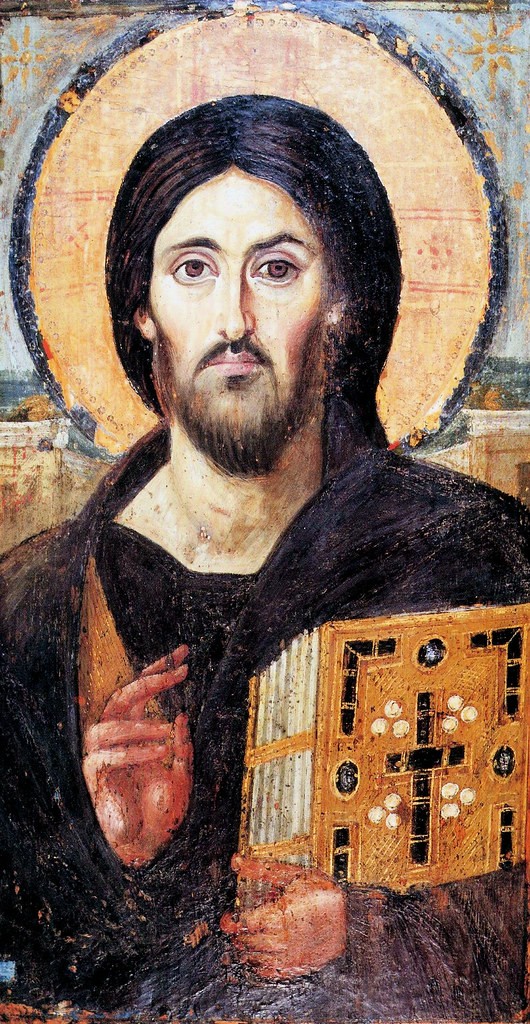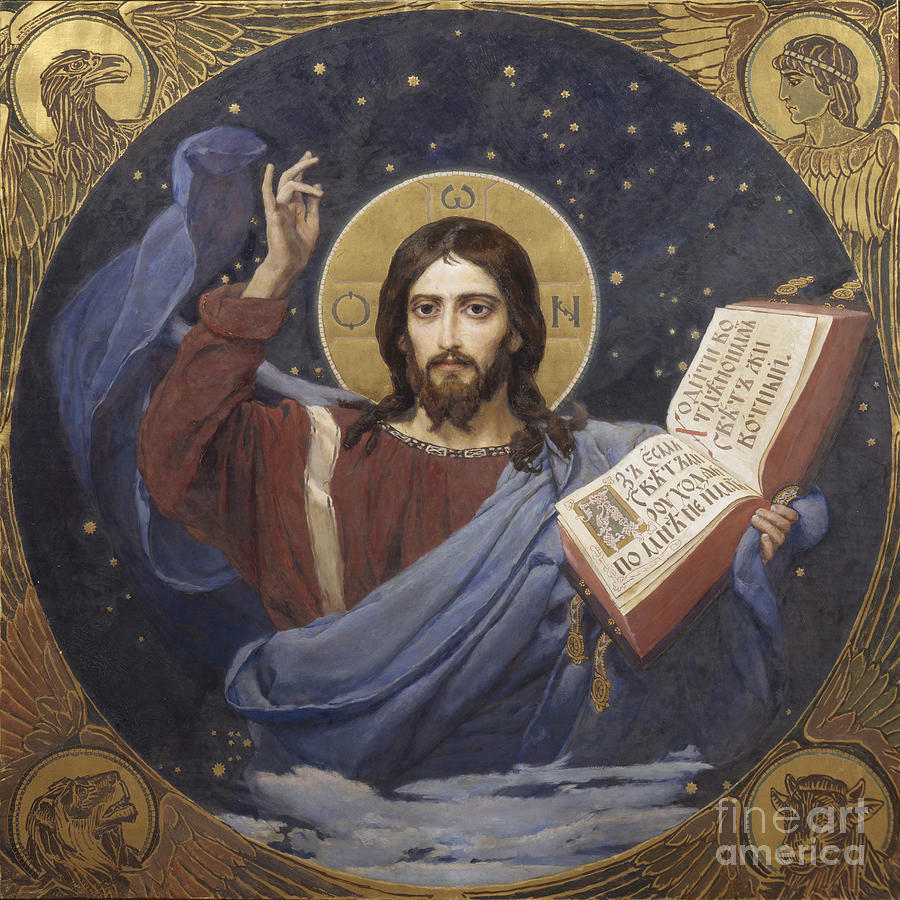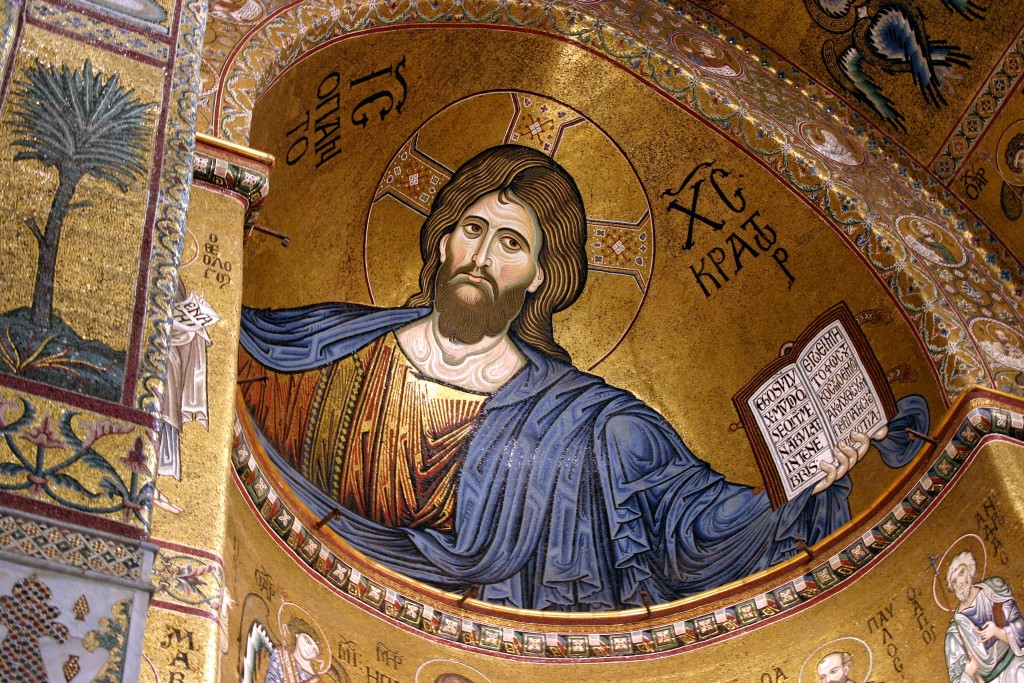
Revelation 19
11 Then I saw heaven opened, and behold, a white horse! The one sitting on it is called Faithful and True, and in righteousness he judges and makes war. 12 His eyes are like a flame of fire, and on his head are many diadems, and he has a name written that no one knows but himself. 13 He is clothed in a robe dipped in blood, and the name by which he is called is The Word of God. 14 And the armies of heaven, arrayed in fine linen, white and pure, were following him on white horses. 15 From his mouth comes a sharp sword with which to strike down the nations, and he will rule them with a rod of iron. He will tread the winepress of the fury of the wrath of God the Almighty. 16 On his robe and on his thigh he has a name written, King of kings and Lord of lords. 17 Then I saw an angel standing in the sun, and with a loud voice he called to all the birds that fly directly overhead, “Come, gather for the great supper of God, 18 to eat the flesh of kings, the flesh of captains, the flesh of mighty men, the flesh of horses and their riders, and the flesh of all men, both free and slave, both small and great.” 19 And I saw the beast and the kings of the earth with their armies gathered to make war against him who was sitting on the horse and against his army. 20 And the beast was captured, and with it the false prophet who in its presence had done the signs by which he deceived those who had received the mark of the beast and those who worshiped its image. These two were thrown alive into the lake of fire that burns with sulfur. 21 And the rest were slain by the sword that came from the mouth of him who was sitting on the horse, and all the birds were gorged with their flesh.
There is a word that is used a number of times in the book of Revelation—nine times in fact, and twice in Revelation 19—that is important and that has given rise to a particular artistic depiction of Jesus in iconography and painting. The word is “pantocrator” and it shows up in Revelation 19:15, “God the Almighty.” “Pantocrator” is a Greek word that means “almighty” and when used to describe a certain type of depiction of Jesus it is called “Christ Pantocrator”: Χριστὸς Παντοκράτωρ.
Here is an early example, the oldest existing one in fact, a 6th century Orthodox icon of “Christ Pantocrator.” It is also one of my favorite images of Jesus.

Here is another example, this one from the late 19th century.

I think my favorite “Christ Pantocrator,” or “Christ Almighty,” example is found in the dome of the Cathedral of Monreale in Italy.

Here, Christ has the traditional “Pantocrator” pose of two fingers raised on the right hand, a copy of the New Testament in His left hand, and a stern look on His face. “Christ Pantocrator” depicts Jesus as strong, as almighty, and, indeed, as one with whom we dare not trifle. This is the strong Christ, Christ resolved to complete His task, Christ who will judge and overthrow the powers, Christ who is mighty to save His people.
I look at “Christ Pantocrator” images and I wonder, “Is this good? Should Christ be depicted thus? Should He not be depicted here as gentle and lowly?” And I read Revelation 19 and I think, “Yes, it is good! Yes, He should be so depicted!” For in Revelation 19 Christ comes to defeat the powers. In Revelation 19, Christ mounted upon a white horse and comes in victory in strength.
Christ Pantocrator: Christ Almighty
Our first point is captured by the Greek words, “Christ Pantocrator,” “Christ Almighty!” Here, Jesus is depicted as strong, as awesome, as able to defeat all powers. Behold:
11 Then I saw heaven opened, and behold, a white horse! The one sitting on it is called Faithful and True, and in righteousness he judges and makes war. 12 His eyes are like a flame of fire, and on his head are many diadems, and he has a name written that no one knows but himself. 13 He is clothed in a robe dipped in blood, and the name by which he is called is The Word of God.
Heaven opens and Christ, mounted now on a white war horse, advances. He is not immediately identified as Christ, but it is abundantly clear who is being referred to. He is faithful and true, and these words are used of Christ in His introduction to the church of Laodicea in Revelation 3:14. He is the righteous judge. His eyes of flame take us back to Revelation 1:14 (“His eyes were like a flame of fire…”) and 2:18 (“The words of the Son of God, who has eyes like a flame of fire…”). In both of these examples the one with eyes of flame is clearly Jesus. He has “many diadems,” which takes us back to Matthew Bridges 1851 lyrics, “Crown Him with many crowns…”
Shockingly, He is wearing “a robe dipped in blood.” This image has proven controversial over the years. Whose blood is it? On the one hand a case can be made that this is the blood of those Christ conquers when He brings judgment. “In light of the immediate context of spiritual warfare,” writes Scott Duvall, “most identify the blood as belonging to God’s enemies (cf. Isa. 63:1–3; Rev. 14:20; 19:15).”[1] We should say that by “most” Duvall is likely referencing modern scholars. But there is some warrant for this. After all, it is quite likely that this image is fulfilling the image of God found in Isaiah 63.
1 Who is this who comes from Edom, in crimsoned garments from Bozrah, he who is splendid in his apparel, marching in the greatness of his strength? “It is I, speaking in righteousness, mighty to save.” 2 Why is your apparel red, and your garments like his who treads in the winepress? 3 “I have trodden the winepress alone, and from the peoples no one was with me; I trod them in my anger and trampled them in my wrath; their lifeblood spattered on my garments, and stained all my apparel. 4 For the day of vengeance was in my heart, and my year of redemption had come. 5 I looked, but there was no one to help; I was appalled, but there was no one to uphold; so my own arm brought me salvation, and my wrath upheld me. 6 I trampled down the peoples in my anger; I made them drunk in my wrath, and I poured out their lifeblood on the earth.”
So, yes, it is possible that this is blood of the enemies of God and that this image is intended to speak of His victory over the forces of evil.
And yet others argue that the blood is Christ’s own blood, symbolizing how He conquers through His obedience on the cross. And there is certainly warrant for this idea! For instance, the New Testament scholar Eugene Boring makes this argument when he writes:
This view that the eschatological Divine Warrior is red with his own blood rather than that of his enemies, while championed by the Church Fathers, has been challenged by some modern scholars and pronounced “absurd” by one (Müller, p. 327). Yet it is not absurd for one who can define “conquering” as “dying” and “Lion” as “Lamb” (5:1–7). It is analogous to the idea that Christians wash their garments and make them white in the blood of the Lamb (7:14). John’s theology as a whole calls for this interpretation. He uses the ancient form of portraying the ultimate victory of God as winning a great battle in which those who have resisted God are slaughtered. But he fills this with new content. This is simply what has happened in the Christian confession as such, that the Christ, the triumphant military king, is Jesus, the crucified man of Nazareth, who was crucified not as preliminary to his victory but as his victory.[2]
Once again, let us be humble here. I am inclined to lean toward this being the blood of Christ, yet the militaristic imagery of Revelation 19 and those chapters preceding it does leave open the possibility that this is the blood of those slain in judgment.
Of course, one may ask whether or not it might be both: the blood that speaks of salvation and the blood that speaks of judgment.
Perhaps the biggest clue that this is Jesus is that in verse 13 the one seated on the horse is “The Word of God.” And this, of course, reminds us of John’s earlier description of Jesus from the first chapter of John’s gospel:
1 In the beginning was the Word, and the Word was with God, and the Word was God.
With Christ comes an army.
14 And the armies of heaven, arrayed in fine linen, white and pure, were following him on white horses.
I agree with John McCallum who writes of these “armies of heaven”:
These are likely the saints of heaven and angelic hosts. According to 1 Thessalonians 4:16-17, I believe they will be joined on the way down by believers on the earth who are snatched up to meet the Lord in the air.[3]
It should be noted, however, that some distinguish the army from the Bride, who is the church, and suggest that the army consists only of angelic hosts. Then we have more strong images of Christ Pantocrator.
15 From his mouth comes a sharp sword with which to strike down the nations, and he will rule them with a rod of iron. He will tread the winepress of the fury of the wrath of God the Almighty. 16 On his robe and on his thigh he has a name written, King of kings and Lord of lords.
Here, Christ comes in stern judgment and unbending strength. He comes here not with a cross but with the sword of His word and an iron rod to rule. What is more, Christ comes in wrath, the wrath of God the Almighty. Upon his thigh we find a title, “King of kings and Lord of lords.” About this title Duvall writes, “This Old Testament title for God is now used of Christ to affirm his sovereignty over all competing earthly rulers, Caesar included (Deut. 10:17; Dan. 2:47; Zech. 14:9; 1 Tim. 6:15; Rev. 1:5; 17:14).”[4]
This cannot be passed over quickly. In Revelation the deity of Jesus is clearly proclaimed. This is Jesus, God with us, Jesus, the divine second person of the Trinity. Here, Jesus is unveiled! He comes in might and power, as the angelic angel proclaims a chilling note of doom:
17 Then I saw an angel standing in the sun, and with a loud voice he called to all the birds that fly directly overhead, “Come, gather for the great supper of God, 18 to eat the flesh of kings, the flesh of captains, the flesh of mighty men, the flesh of horses and their riders, and the flesh of all men, both free and slave, both small and great.”
I repeat: there must be room for Christ Pantocrator in your view of Jesus. There must be room for Christ Almighty, Christ the warrior God! He comes first meek and lowly, a baby in a manger. He comes again on a warhorse in bloodstained garments with a sword and a rod and the wrath of God.
Let us make no mistake: any theology that cannot handle this picture of Jesus is stunted and any church that flinches in announcing that one day this Jesus will turn His fiery eyes upon the beast and the false prophet and the wicked powers of the earth is preaching a partial gospel.
No, see Him there, Christ Pantocrator! Christ Almighty! See Him and tremble!
Christus Victor: Christ the Victor
Our second point is captured by another famous title for Jesus—this time a Latin title—“Christus Victor,” “Christ the Victor!” Here we see Jesus victorious over the forces of evil at the battle of Armageddon.
19 And I saw the beast and the kings of the earth with their armies gathered to make war against him who was sitting on the horse and against his army.
Ah! We sit up in our seats and prepare ourselves for the great clash! We are ready to see this epic battle that we have waited to behold. We have a strong feeling about who will win, but what will this mighty army of the enemies of God do? What tricks do they have up their sleeves? How will they fare in their doomed clash with King Jesus. Let us see!
20 And the beast was captured, and with it the false prophet who in its presence had done the signs by which he deceived those who had received the mark of the beast and those who worshiped its image. These two were thrown alive into the lake of fire that burns with sulfur. 21 And the rest were slain by the sword that came from the mouth of him who was sitting on the horse, and all the birds were gorged with their flesh.
I mean…is that it?!
Brothers and sisters, if ever there was an anticlimactic battle, this is it!
T.S. Eliot’s conclusion to his 1925 poem “The Hollow Men” comes immediately to mind:
This is the way the world ends
This is the way the world ends
This is the way the world ends
Not with a bang but a whimper.
Something else comes to mind. I remember back when Mike Tyson was in his prime how furious people started getting when Tyson would come out and knock some poor soul out in less than one or two minutes. I remember people complaining about how much they paid for a ticket only for the fight to be over pretty much when it began.
The same dynamic is at work here. This fight is over before it begins. It is not even a fight.
Why? Because who can stand against King Jesus?!
What fools think they can stand up to the Lord of all life!
Christ Pantocrator!
Christus Victor!
And here something dawns on us: if this almighty and victorious King can vanquish the forces of evil and wickedness and godlessness like this, can He not overcome my own shame and my own guilt and my own wickedness and save me if I cry out to Him? If He can overcome the beast at Armageddon, can He not overcome the beast in my own life? Can He not give me freedom? Can He not break my chains?
And then we dare to think yet another thought. If Christ is this kind of conqueror, could it be that if I gave my life to Him He could give me victory as well over the demons that plague me, over the devil that harasses me, over the sin that clings to me, over my own mind and heart that condemns me? And no sooner have we thought this than we hear the words of Romans 8 ringing out across the heavens:
37 …in all these things we are more than conquerors through him who loved us.38 For I am sure that neither death nor life, nor angels nor rulers, nor things present nor things to come, nor powers, 39 nor height nor depth, nor anything else in all creation, will be able to separate us from the love of God in Christ Jesus our Lord.
Ah! So there it is: we will either be conquered by His love or we will be conquered by His wrath. Let it be His love! Receive His love today!
Christ Pantocrator!
Christus Victor!
Jesus, the Almighty!
Jesus, the Victorious!
[1] Duvall, J. Scott. Revelation (Teach the Text Commentary Series) (p. 269). Baker Publishing Group. Kindle Edition.
[2] Boring, M. Eugene. Revelation. Interpretation: A Bible Commentary for Teaching and Preaching (pp. 196-197). Presbyterian Publishing Corporation. Kindle Edition.
[3] McCallum, John. Revealed: The Sweeping Story of Revelation (p. 114). Kindle Edition.
[4] Duvall, p. 269..

Your series in Revelation has been really good BUT also since chapter 17 onward a wee bit scary and exciting all @ once; inclined sometimes to hide in a cave or at least cry myself to sleep @ my bedside; both sentiments come and go lately; me does not mind saying lately and more so the last two years……… I’m afraid of God; reminds me of William Cowper who established a moment to Richard Hooker in England in 1632; both had …….well, let us say Cowper understood Hooker perhaps more than most; Hooker died @ age 46 or 12 years after marriage. That Cowper thought that much of him is NO small thing. just love the “memories” your sermons stir up lately, Go Wym!…….. meatloaf is optional
just love the “memories” your sermons stir up lately, Go Wym!…….. meatloaf is optional